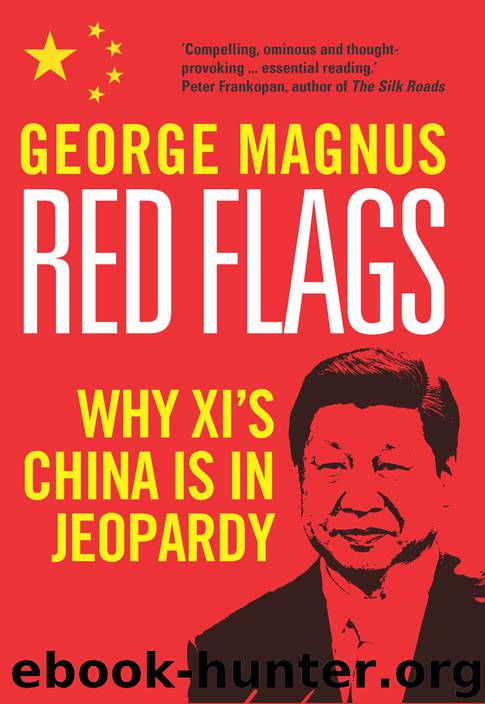Red Flags: Why Xi's China Is in Jeopardy by George Magnus

Author:George Magnus [Magnus, George]
Language: eng
Format: epub
Tags: History, Modern, 21st Century, Asia, China, Political Science, Public Policy, Economic Policy
ISBN: 9780300240955
Google: JxttDwAAQBAJ
Amazon: 0300233191
Publisher: Yale University Press
Published: 2018-09-11T00:41:29.358000+00:00
China’s demographic dividend is banked
In 2012, China’s WAP fell for the first time, by 3.45 million people, and the rate of decline is going to accelerate significantly after 2020, with the biggest annual losses (around 7 million a year) occurring between 2025 and 2035. From a current level of just over 1 billion people, the WAP is predicted to decline by 213 million by 2050. This equates to an average drop of 0.7 per cent per year, which feeds directly into lower trend GDP growth, which may be no higher than 3, possibly 4 per cent.
As the WAP declines, the number of older people will continue to rise relentlessly. Those aged over sixty, numbering around 209 million in 2015 (just over 15 per cent of the population) will increase to 294 million by 2025 (21 per cent of the population), and 490 million (36.5 per cent) by 2050. By then, there will be nearly three times as many older citizens as children.
The old-age dependency ratio, which is the number of over-65-year-olds as a proportion of the WAP, is predicted to rise from 13 per cent today, to over 20 per cent in 2025 and 47 per cent by 2050. Put another way, the 7.7 workers who support each older citizen today will be just 2.1 workers by 2050. China’s old-age dependency ratio will still be less than that of Japan and South Korea by then but significantly higher than the US (37 per cent), let alone India (20 per cent).
It is an intriguing question as to why China is ageing so rapidly, especially in relation to other emerging and developing nations. As suggested, though, the combination of the family planning policies adopted in the 1970s and the one-child policy brought the demographic dividend to China much earlier. They lowered child dependency sooner, and have now left the country with premature ageing by comparison. While India’s demographic dividend phase is only just starting – a third of the population is aged under fifteen – China’s began in the early 1970s, and achieved its maximum effect in the quarter century to about 2012.
We can judge premature ageing by comparing China with some of its Asian neighbours when they had China’s current income per head many years ago. For example, China’s age structure – or the ratio of over-sixties to those aged 0–14 – is two to three times as high as it was in Japan, South Korea and Taiwan. Moreover, the size of China’s working-age population today is significantly larger than it was for these countries, meaning they were able to look forward to further demographic dividend years. China’s potential for future growth, therefore, is much less by comparison, because the share of younger workers in the economy is substantially lower, and China’s WAP is now declining.6
Another indicator that China’s demographic dividend has been banked is the pattern of unemployment, which has probably been rising. There is a problem of measurement here because, like other emerging countries, China lacks a robust system for recording employment and, especially, unemployment.
Download
This site does not store any files on its server. We only index and link to content provided by other sites. Please contact the content providers to delete copyright contents if any and email us, we'll remove relevant links or contents immediately.
| Arms Control | Diplomacy |
| Security | Trades & Tariffs |
| Treaties | African |
| Asian | Australian & Oceanian |
| Canadian | Caribbean & Latin American |
| European | Middle Eastern |
| Russian & Former Soviet Union |
The Secret History by Donna Tartt(16623)
The Social Justice Warrior Handbook by Lisa De Pasquale(11489)
Thirteen Reasons Why by Jay Asher(7788)
This Is How You Lose Her by Junot Diaz(5772)
Weapons of Math Destruction by Cathy O'Neil(5037)
Zero to One by Peter Thiel(4824)
The Myth of the Strong Leader by Archie Brown(4789)
Promise Me, Dad by Joe Biden(4447)
Beartown by Fredrik Backman(4418)
Stone's Rules by Roger Stone(4415)
How Democracies Die by Steven Levitsky & Daniel Ziblatt(4398)
The Fire Next Time by James Baldwin(4342)
100 Deadly Skills by Clint Emerson(4077)
A Higher Loyalty: Truth, Lies, and Leadership by James Comey(4032)
Rise and Kill First by Ronen Bergman(4012)
The David Icke Guide to the Global Conspiracy (and how to end it) by David Icke(3881)
The Farm by Tom Rob Smith(3872)
Secrecy World by Jake Bernstein(3782)
The Doomsday Machine by Daniel Ellsberg(3731)
